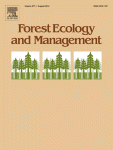Ver ítem
- xmlui.general.dspace_homeCentros Regionales y EEAsCentro Regional Buenos Aires NorteEEA Delta del ParanáArtículos científicosxmlui.ArtifactBrowser.ItemViewer.trail
- Inicio
- Centros Regionales y EEAs
- Centro Regional Buenos Aires Norte
- EEA Delta del Paraná
- Artículos científicos
- Ver ítem
Influence of growth dominance and individual tree growth efficiency on Pinus taeda stand growth. A contribution to the debate about why stands productivity declines
Resumen
A well recognized pattern during even-aged stands development is the growth decline after reaching a peak. We studied the effect of changes in stand structure, characterized by growth dominance, upon stand growth, stand growth efficiency and tree growth efficiency in thinned and unthinned plots of Pinus taeda. According to the stated hypothesis (Binkley, 2004), stand growth decline would be related to a decrease in growth efficiency of smaller trees due
[ver mas...]
A well recognized pattern during even-aged stands development is the growth decline after reaching a peak. We studied the effect of changes in stand structure, characterized by growth dominance, upon stand growth, stand growth efficiency and tree growth efficiency in thinned and unthinned plots of Pinus taeda. According to the stated hypothesis (Binkley, 2004), stand growth decline would be related to a decrease in growth efficiency of smaller trees due to the increase of growth dominance. Growth dominance in unthinned plots continuously increased with age, although it was very low compared to other genus, particularly Eucalyptus. In thinned plots, growth dominance was even lower and no consistent trend through time was observed. In general large trees were more efficient than small trees in unthinned and thinned plots, however, growth efficiency of both, small and large trees, showed the same pattern with age. Nevertheless, in both treatments, the difference between growth efficiency of smallest and largest trees increased with developing growth dominance because the increasing difference in tree size with age. At stand level lower growth dominance levels did not result in higher stand growth efficiency. Based on the low growth dominance levels, we cannot conclude that increasing growth dominance during stand development can be responsible for its growth decline. Growth dominance appears not to be the cause but the consequence of growth efficiency differentiation between small and large trees of a stand.
[Cerrar]

Fuente
Forest ecology and management 277 : 116-123. (1 August 2012)
Fecha
2012-08
Editorial
Elsevier
ISSN
0378-1127
Formato
pdf
Tipo de documento
artículo
Palabras Claves
Derechos de acceso
Restringido
 Excepto donde se diga explicitamente, este item se publica bajo la siguiente descripción: Creative Commons Attribution-NonCommercial-ShareAlike 2.5 Unported (CC BY-NC-SA 2.5)
Excepto donde se diga explicitamente, este item se publica bajo la siguiente descripción: Creative Commons Attribution-NonCommercial-ShareAlike 2.5 Unported (CC BY-NC-SA 2.5)

